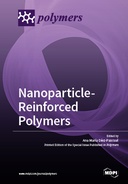Explore

Nanoparticle-Reinforced Polymers
0 Ungluers have
Faved this Work
Login to Fave
This book, a collection of 12 original contributions and 4 reviews, provides a selection of the most recent advances in the preparation, characterization, and applications of polymeric nanocomposites comprising nanoparticles. The concept of nanoparticle-reinforced polymers came about three decades ago, following the outstanding discovery of fullerenes and carbon nanotubes. One of the main ideas behind this approach is to improve the matrix mechanical performance. The nanoparticles exhibit higher specific surface area, surface energy, and density compared to microparticles and, hence, lower nanofiller concentrations are needed to attain properties comparable to, or even better than, those obtained by conventional microfiller loadings, which facilitates processing and minimizes the increase in composite weight. The addition of nanoparticles into different polymer matrices opens up an important research area in the field of composite materials. Moreover, many different types of inorganic nanoparticles, such as quantum dots, metal oxides, and ceramic and metallic nanoparticles, have been incorporated into polymers for their application in a wide range of fields, ranging from medicine to photovoltaics, packaging, and structural applications.
This book is included in DOAB.
Why read this book? Have your say.
You must be logged in to comment.
Rights Information
Are you the author or publisher of this work? If so, you can claim it as yours by registering as an Unglue.it rights holder.Downloads
This work has been downloaded 386 times via unglue.it ebook links.
- 55 - pdf (CC BY-NC-ND) at Unglue.it.
Keywords
- active layer
- Adhesion
- Ag nanoparticles
- bismaleimide
- carbon nanoparticles
- carrier transport
- Catalysis
- chain topology
- chemical and physical interface
- clays
- colorimetric sensor
- composite membrane
- composites
- conductive polymer
- conjugated polymer nanoparticles
- crystallization kinetics
- electric energy storage
- electrical breakdown
- electrical property
- electrode
- fluorescence resonance energy transfer
- fluorescent assay
- FRET
- gas barrier properties
- gold nanoparticles
- Graphene
- graphene oxide
- graphene-like WS2
- hybrid hydrogels
- in situ synthesis
- in-situ synthesis
- inorganic nanotubes
- interfacial layer
- latex compounding method
- layered structures
- Mechanical properties
- melamine
- metal oxides
- molecular chain motion
- Morphology
- N-isopropylacrylamide
- N-isopropylmethacrylamide
- n/a
- nano-hybrids
- nanocomposite
- nanocomposites
- nanomaterials
- Nanoparticles
- nanosheets
- optoelectronic properties
- organic light-emitting diodes (OLEDs)
- PFO/MEH-PPV hybrids
- PHBV
- polyethylene
- polymer-matrix composites
- polymer-NP interface
- Polymers
- polypropylene nanocomposite
- power cable insulation
- power-conversion efficiency
- ratiometric temperature sensing
- reduced graphene oxide
- selective adsorption
- Separation
- silica/NR composite
- silver ions
- SiO2 microspheres
- SiO2/TiO2 nanocomposite
- solar cell
- sol–gel
- structure-property relationship
- surface modification of silica
- thema EDItEUR::P Mathematics and Science::PN Chemistry
- thermoplastic nanocomposite
- thermoresponsive hyperbranched polymer
Links
DOI: 10.3390/books978-3-03921-284-2Editions


